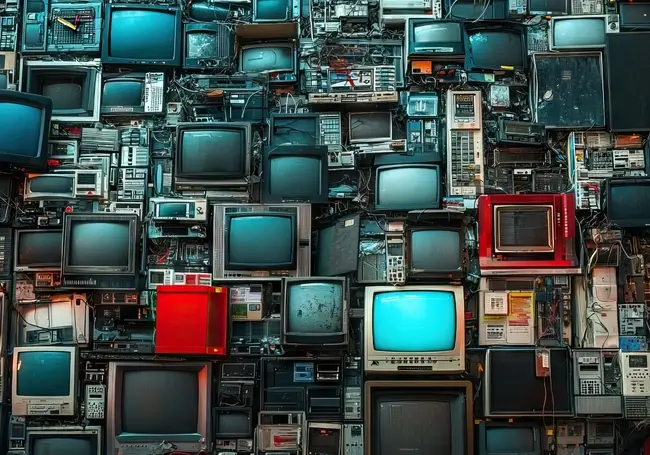
Generative artificial intelligence (Gen-AI) applications have begun contributing to electronic waste (e-waste) that’s detrimental to the environment.
Many have been questioning the impact of AI technologies on the environment. Could it be a setback to the 2050 net zero target?
Scientists from the Chinese Academy of Sciences' Institute of Urban Environment and Reichaman University in Israel carried out a study to calculate the future e-waste that will be caused by gen-AI applications.
The study found that the e-waste stream could increase, potentially reaching a total accumulation of 1.2–5.0 million tons during 2020–2030, under different future gen-AI development settings.
Gen AI applications such as OpenAI’s ChatGPT, Meta’s Llama, Anthropic’s Claude, or Google’s Gemini need a huge load of computational power to function.
They require a specific type of hardware that functions on specialised GPUs which are plugged into certain computers. These computers are stored together in data centres and server farms.
In fact, the Electric Power Research Institute (EPRI) found that data centres could grow to consume up to 9% of US electricity generation annually by 2030, up from 4% of total load in 2023.
In September, The Guardian reported that data centre emissions are 662% higher than what big tech companies like Google, Microsoft, Meta and Apple claim officially.
This background process of using gen-AI can be quite taxing computationally. Data centre demand has grown exponentially since the boom in AI this decade.
Goldman Sachs Research claims that data centre power demand is projected to grow 160% by 2030.
Up to 5.0 Million Metric Tons of E-Waste Projected
If the e-waste caused by the demand and usage of gen-AI is not tackled now, the new study’s researchers believe that the AI industry could yield about 1.2 to 5.0 million metric tons of e-waste by the end of the decade.
This e-waste comes from mainly the equipment stored in data centres. Since almost all electronic equipment has a shelf life, they tend to become obsolete and have to be discarded somehow.
The e-waste could include computers, their parts, batteries, circuit boards and other electronic hardware items housed in data centres.
To curb the e-waste caused by the expansion of gen-AI applications, the study came up with a computational power-driven material flow analysis framework.
The authors introduced the computational framework to “quantify and explore ways of managing the e-waste generated” by gen-AI. The model particularly focused on large language models (LLMs).
The model also estimated the annual production of e-waste increasing from 2.6 thousand metric tons in 2023. This could possibly go up to 2.5 million metric tons per year by the end of the decade.
After projections, the researchers suggest that deploying circular economy strategies for the gen-AI value chain could reduce e-waste generation by 16 to 86%.
What is e-waste?
Electronic waste (e-waste) is obsolete devices or discarded electronic items often with a battery or plug and their components that often end up in landfills. Some of the most common ones include computers, mobile phones, large household appliances, and medical equipment.
According to Proactive, e-waste is already the planet’s fastest-growing waste stream and the AI industry’s demands are exacerbating this trajectory.
Why is e-waste a problem?
E-waste is one of the fastest-growing solid waste streams in the world. About 61.3 million tonnes of e-waste was generated in 2023 alone as per the United Nations. This is equivalent to 8 kilograms of e-waste per person – more than the weight of the Great Wall of China.
This is a massive problem because e-waste releases toxic compounds like lead, mercury and cadmium that are detrimental to not only the environment but also the health of communities living near landfills.
These harmful compounds can seep into the soil and water which could severely affect groundwater systems, destroy soil or damage the overall ecosystems. If indirectly consumed by living creatures, such compounds pose serious health risks such as neurological disorders, reproductive problems, respiratory issues, kidney damage and even cancer.
2023 witnessed a jump in e-waste of roughly 13% compared to 2021 when the global e-waste was nearly 54.4 million metric tonnes (Reuters).
Barely a small fraction of the e-waste is collected for recycling. According to UNITAR, less than one quarter (22.3%) of the year’s e-waste mass was documented as having been properly collected and recycled in 2022, leaving US $62 billion worth of recoverable natural resources unaccounted for and increasing pollution risks to communities worldwide.
How do we dispose of e-waste?
Currently, e-waste is disposed of in landfills where the discarded items end up in huge holes in the ground.
Some other techniques also include acid baths where electronic circuits are soaked in strong sulphuric, hydrochloric, or nitric acid solutions to separate metals from the electronic pathways. The separated metal can be recycled for further use but the acid waste is highly hazardous and needs a safe disposal method.
Incineration is another method which requires burning the e-waste in an extremely high-temperature incinerator. While this application generates toxic gases in the air, it has two benefits – reduces waste volume and the energy generated from burning can be used to power other processes or generate electricity.
E-waste can also be disposed of at a local facility or a recycling centre that allows individuals to submit their obsolete electrical items. The facility should have the right kind of reprocessing plant that recycles or specialises in refurbishing electronics by dismantling electronics for parts.
Some charities like the British Heart Foundation also accept electronic items that are suitable to be re-used.
How do we recycle e-waste?
Recycling e-waste involves dismantling the electronics for parts which are then refurbished into new products. However, it also depends on the type of item that is being recycled.
At recycling facilities, e-waste is shredded into small parts Many electronics will be scanned for materials that need to be separated especially, metals, plastics and hazardous materials. It then goes through refurbishing pants and is then refurbished.












